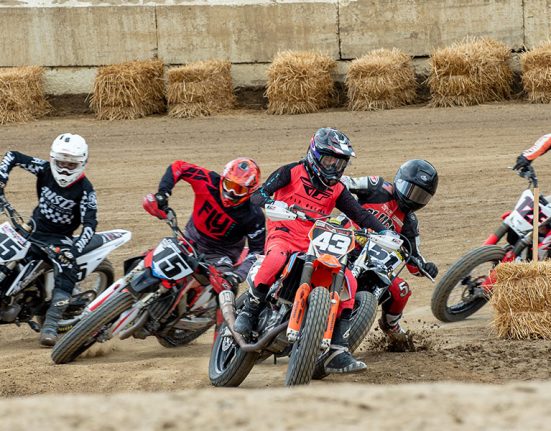Honda dusts off a late 1980s ADV nameplate and scores. Is Less More? Yes!
Jan. 19, 2024 (Story from the January 2024 edition of American Motorcyclist)
By John Burns
Downsizing being all the rage these days, here comes Honda right on schedule with an all-new lighter, friendlier, and cheaper ADV bike. Sure the Africa Twin is a great adventurer, but most of us middle-aged cheapskates aren’t Cyril Despres, and most of our adventures don’t require 100+ horsepower, super long-travel suspension or a foot of ground clearance.
Most of us don’t want to pick up a 500-pound plus motorcycle when it invariably tips over in the most awkward place, either, and I, for one, see no need to shell out 15 or 20 g’s for a motorcycle whose potential mocks my skill set. Especially when Honda invited us to sample the all-new Transalp 750 on Backroad Discovery Route’s Pennsylvania trek.
With its 4.5-gallon tank full (half-a-gallon less than Africa Twin), Honda says the Transalp’s 459-lb wet weight undercuts the base AT by 46 lbs. in spite of its steel frame. The Transalp’s seat is 33.7 inches from the ground, but there’s also a low-seat option that takes it down to 33.3 in. My 30-inch legs felt pretty confident on either one, able to get my foot balls down on both sides as the 43mm Showa SFF-CA inverted fork groaned through part of its 7.9-inch travel as my massive mass settled in, and the Pro-Link Showa shock used up more than a little of its 7.5-inch travel.
I’ve toppled over more than once from a standstill on Yamaha Tenere 700s, whose seat height claim is 34.4 in. That extra inch is an angry one indeed. Not only is the Transalp seat lower, it’s also broader and more comfortable than the Tenere’s more dirtbikey one, which is a big reason why the Honda feels considerably “streetier” than the Yamaha.
Speaking of the Tenere, we’ve been singing the praises of its spunky 689cc parallel Twin since the first FZ-07 got here in 2015. With its own all-new parallel twin, Honda takes everything we like about that engine and kicks it up about three notches. 755cc isn’t much bigger than the Yamaha, but the Honda’s Unicam head and more oversquare dimensions conspire to have the Transalp moving out from 2,000 rpm on up with more authority than you expect from a 750. The engine also spins up more enthusiastically than the Tenere’s.
The U.S. version adheres to sound restrictions that limit horsepower compared to the 90.5 bhp at 9,500 rpm Honda claims for the Euro version, but it doesn’t have much less, and still feels plenty fast. At 4,000 rpm, the engine’s producing serious thrust, and between 6,000 and 8,000 rpm the angry animal trapped in the airbox and being poked with the 270-degree crank through the Vortex flow ducts is screaming to get out. If you want to bounce the tach needle off its soft limiter (just past 10k on the analog-looking TFT tach) as you scatter leaves on Pennsylvania dirt roads, you can. The standard up/down quickshifter makes it easy to keep things screaming, and especially helps with smooth downshifts on those loose surfaces, too; engine braking is three-way adjustable. (When you do want the clutch, its slip-assist function gives it a really light pull and smooth engagement.)
Alternatively, when you tire of standing on the pegs and trying to keep up with the fast kids, you can just sit down on the cush seat, dial it back to cruise mode, and take in the Pennsylvania BDR’s glorious fall scenery. The Transalp encourages that, as the width of the gas tank makes standing on the pegs slightly awkward. On smoothish gravel roads (most of the BDR), the ride’s impeccable. On the couple of gnarlier rocky sections we encountered, with the rocks mostly invisible under a carpet of leaves, you might wish for the Africa Twin’s more sophisticated suspension and a steering damper. But it’s all good.
Actually, there is no Cruise mode, but there are Sport, Standard, Gravel, Rain, and a customizable User mode. In User, you can switch to Off-road ABS, which disables rear ABS, and you can turn off traction control, too (HSTC, Honda calls it). It’s all easy for even a technophobe to operate quickly with the left-thumb button. Personally, I like a little HSTC, of which there are five levels. A couple of too-sideways times out of loose gravelly corners just as my medulla oblongata was seizing up, the Honda brain had already stepped in to slow the rear’s spinning and straighten things out. A man’s got to know his limitations — and when he doesn’t, it’s nice to have a machine that does.
On top of all that, after 1.5 days of riding 80 percent dirt roads, my bike’s computer said it was getting 45 mpg, and the computers on the fastest guys’ bikes, who were flogging their Transalps the whole time, read between 50 and 54 mpg. Not sure how that works, but I like it.
All in all, for $9,999, this is a helluva motorcycle that I alas, cannot wholeheartedly endorse, because they left off my favorite gadget: cruise control. If you’re one of those people who claims to not care about cc (Yamaha sold plenty of Teneres without it), then there’s nothing stopping you. Except that American Honda is only bringing in the Matte Black Metallic, and not the lovely white one available abroad. Those two things aside, I wouldn’t try to talk you down from this one. Very nice.






